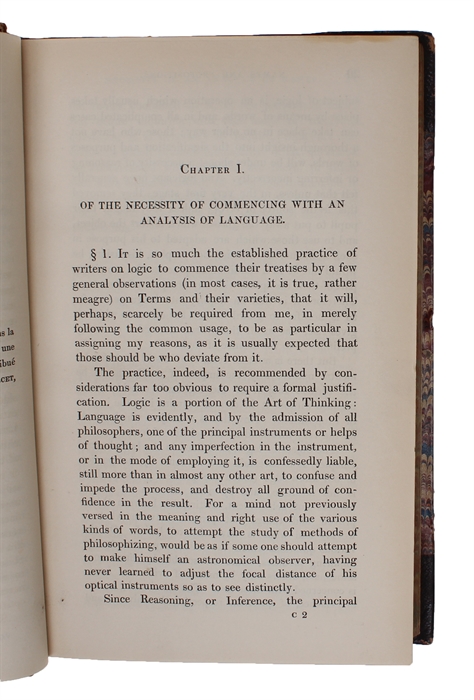THE SCIENTIST'S CLAIM TO TRUTH
MILL, JOHN STUART.
A System of Logic, Ratiocinative and Inductive, Being a Connected View of the Principal Evidence, and the Methods of Scientific Investigation. In Two Volumes. 2 vols.
London, John W. Parker, 1843.
8vo. 2 uniform contemporary half calf bindings with five raised gilt bands to gilt spines. Marbled edges. A nice and tight set with only minor wear to extremities. Vol. 1 with tiny damp-stainin to upper margin, barely affecting but a little bit of the end-papers and the first three leaves - here only the top blank margin, far from affecting any text. Blank leaves a bit brownspotted, otherwise also internally very nice and clean. (2), XVI, 580; (2), XII, 624 pp. Bookplate of "Reginald Dykes Marshall" to inside of both front boards.
The scarce first edition of what is probably Mill's greatest book, an epochal work in logical enquiry, not only for British philosophy, but for modern thought in general.
"Mill's most important work in pure philosophy was his "System of Logic", which he began at the age of twenty-four and completed thirteen years later" (D.S.B. IX:383).
By the first quarter of the 19th century, the theory of logic had been almost overlooked in the English speaking world for centuries. Logic was practiced merely as an academic study on traditional lines, with Aristotle as the great master, but with Mill and some of his contemporaries this was about to change, and Mill's theory of terms, propositions, the syllogism, induction etc., greatly affected 19th century English thought. The many years that Mill allowed himself to work on his "System of Logic" allowed him to be inspired by a number of important steps that were made towards the development of the theory of logic in order to fulfill his groundbreaking work.
Mill's main concern as a philosopher was to overrule the influence of the sceptical philosophers and provide science with a better claim to truth. A main breakthrough in Mill's Logic was thus his analysis of inductive proof, and his originality on this point cannot be denied. "We have found that all Inference, consequently all Proof, and all discovery of truths not self-evident, consists of inductions, and the interpretation of inductions: that all our knowledge, not intuitive, comes to us exclusively from that source. What Induction is, therefore, and what conditions render it legitimate, cannot but be deemed the main question of the science of logic - the question which includes all others. It is, however, one which professed writers of logic have almost entirely passed over. The generalities of the subject have not been altogether neglected by metaphysicians, but, for want of sufficient acquaintance with the processes by which science has actually succeeded in establishing general truths, their analysis of the inductive operation, even when unexceptionable as to correctness, has not been specific enough to be made the foundation of practical rules, which might be for induction itself what the rules of syllogism are for the interpretation of induction... " (A System of Logic, Vol. 1, p. 345) . With his demonstrative theory of induction, Mill reduced the conditions of scientific proof to strict rules and scientific tests. He provided the empirical sciences with formulae and criteria that played as important a role to them as the formulae of syllogism had done to arguments that proceeded from general principles. The laws that Mill established are discovered with his famous "eliminative methods of induction", which later figured prominently in controversies about scientific method.
Mill's Logic came to found a new strand in the theory of logic, logic as incorporated in a general theory of knowledge, where the whole is rendered more precise by its definite reference to the question of proof. According to Mill the ultimate elements of knowledge are subjective entities, however, knowledge does have objective validity.
"Logic alone can never show that the fact A proves the fact B; but it can point out to what conditions all facts must confirm, in order that they might prove other facts. To decide whether any given fact fulfils these conditions, or whether facts can be found which fulfil them in any given case, belongs, exclusively, to the particular art or science, or to our knowledge of the particular subject." (Introduction, § 3, p. 11).
The work underwent several editions, and Mill kept changing it considerably. The first edition is said to have been printed in a small number, less than 1.000.
Order-nr.: 50186





